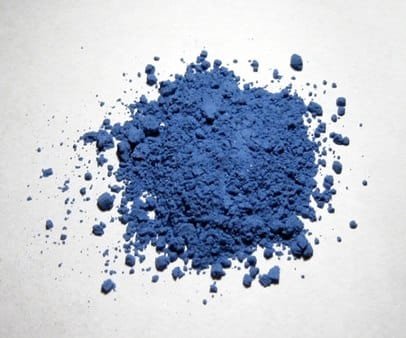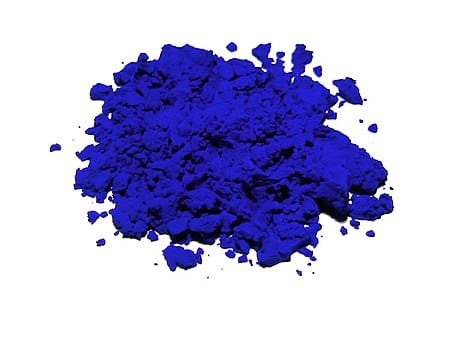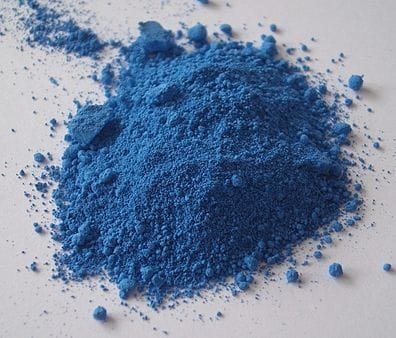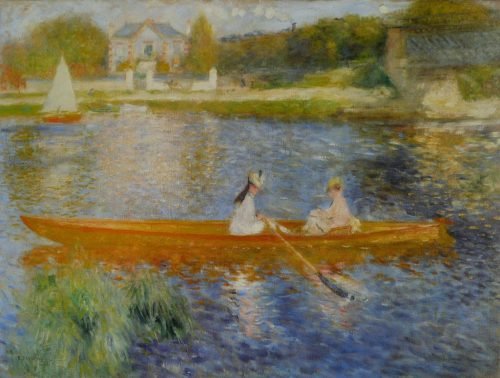A Brief History of Blue~Ancient Blue Pigments

Blue was a difficult color to make in the ancient world. Ancient blue pigments required great skill to produce.
Since blue does not occur frequently in nature, only a limited number of blue pigments exist. Some historians and linguists believe that ancient people did not really develop words for blue until they began making blue pigments.
The history of blue pigments begins with Egyptian blue.
Egyptian Blue

In Ancient Egypt, blue was associated with the sky, the god Amun, and protection against evil. The ancient Egyptians were the first to develop a stable blue colorant from the semi-precious stone, lapis lazuli. The stone was also use in jewelry and to adorn pharaohs’ tombs.

By itself, lapis did not make a satisfactory pigment, but when combined with limestone, sand, and copper and heated to 1,470 and 1,650 degrees Fahrenheit, calcium copper silicate formed. The resulting opaque blue glass could be crushed to yield a saturated, deep turquoise blue pigment called Egyptian blue, or cuprorivaite. The process to make it, though, was complex. So when new blue pigments became available after the end of the Greco-Roman period (332 BC-395 AD), Egyptian blue was largely forgotten.
In 2006, conservation scientist Giovanni Vietri discovered that Egyptian blue glows under fluorescent lights, making it easier for archeologists and historians to identify traces of the color on artifacts
Ultramarine
Although the ancient Egyptians succeeded in developing Egyptian Blue, they did not manage to create a vibrant blue pigment from lapiz lazuli. Impurities such as calcite, pyrite, mica and augite cause ground lapis to change color over time from bright blue to dull grey.

The first ‘true blue’ pigment appeared in the 6th century in Buddhist frescoes in Bamiyan, Afghanistan. Like Egyptian blue, it was made from lapis, but the impurities were refined out of the mineral through a long and complex process.

When the pigment was imported into Europe, it became known as ultramarine, meaning beyond the sea. It became medieval Europe’s most sought-after and expensive color.
Because ultramarine’s price rivaled that of gold, the color was generally reserved for painting royalty or similarly important figures. The 12th century Catholic Church declared the Virgin Mary should be painted in robes of ultramarine. Consequently, the color became associated with humility, virtue and holiness.
Art historians believe Michelangelo’s painting The Entombment (1500-1501) went unfinished for the lack of funds to acquire sufficient ultramarine. Artist Johannes Vermeer (1632-1675) was said to have plunged his family into debt due to his love of the color.

Demand for and the price of ultramarine remained high until the mid-1820’s when France’s Societé d’Encouragement offered a reward of 6,000 francs for the invention of a synthetic version of ultramarine. The prize was won in 1826, with a process that by treating aluminum silicate with sulfur, establishing a new industry dedicated to the manufacture of artificial ultramarine, which all but entirely replaced the natural product.
Azurite


Given the high cost of ultramarine, it is not surprising that alternatives were used. Azurite, a form of copper carbonate, used as a pigment from about 2500 BC to 1800 AD, was a go to substitute for ultramarine. But, as with many inexpensive substitutes, azurite pigments had problems.

.
.
.
.
.
Over time, the pigment would turn greenish-black. Madonna and Child Enthroned with Saints by Raphael is an excellent example of the fate of azurite pigments. The Madonna’s robe, once a brilliant blue, has turned nearly black with time.
.
.
.
.
.
.
.
.
.
.
.
.
.
.
.
.
.
.
.
.
.
.
.
.

Cobalt Blue
Not all blue pigments were used for painting. Cobalt blue was used primarily in ceramics and stained glass.

Made of cobalt alumina salts, cobalt became the chosen pigment for the iconic blue and white Chinese porcelains in the 8th and 9th centuries.
Between 1130 and 1140 AD, Abbe Suger rebuilt the Saint Denis Basilica with cobalt blue stained-glass windows. The blue and red glass together created such a stunning effect that the color became known as the “bleu de Saint-Denis”. Other churches followed suit with blue stained-glass windows.

This vivid blue glass could also be ground into a fine powder to make aa vivid blue-violet pigment similar to ultramarine but far less expensive. 17th century masters made use of this alternative in paintings and frescos.
Commercial production of cobalt blue did not begin until 1807, after a French chemist discovered a purer version of the pigment, leading to wider use of the color.

From the discovery of cobalt blue until the early 1700’s no significant new blue pigments were discovered. The existing piments were blended with other pigments to create various colors of blue, but no new ways of creating blue pigments were identified for hundreds of years, making the discovery of new ones in the 1700’s and beyond notable. We’ll peek in on those next week.
References
Campbell, Robert. The London Tradesman: Being a Compendious View of All the Trades, Professions, Arts, Both Liberal and Mechanic, Now Practised in the Cities of London and Westminster. Calculated for the Information of Parents, and Instruction of Youth in Their Choice of Business. T. Gardner. London. 1747.
Gottesman, Sarah. The 6,000-Year History of Blue Pigments in Art. Artsy. November 29, 2016 Accessed April 25, 2021 https://www.artsy.net/article/artsy-editorial-a-brief-history-of-blue
Kane, Katheryn. Regency Colormen. Regency Redingote. September 30, 2011. Accessed April 23, 2021. https://regencyredingote.wordpress.com/2011/09/30/regency-colormen/
Michaeli, Dov. A Brief But Powerful History of the Colors Purple and Blue . The Doctor Weighs In. February 9, 2021. Accessed April 26, 2021 https://thedoctorweighsin.com/history-purple-blue/
Taggart, Emma. The History of the Color Blue: From Ancient Egypt to the Latest Scientific Discoveries. My Modern Met. February 12, 2018 Accessed April 21, 2021 https://mymodernmet.com/shades-of-blue-color-history/
The Color Blue: History, Science, Facts. Dunned Wards. May 12 2015. Accessed April 19, 2021 ttps://www.dunnedwards.com/colors/specs/posts/color-blue-history
The History and Meaning Behind the Color Blue in Art. Invaluable. December 7, 2018 Accessed April 15, 2021 https://www.invaluable.com/blog/blue-color/
The History Of The Colour Blue . London Fine Arts. August 28 2018. Accessed April 20, 2021 https://londonfineartstudios.com/the-history-of-the-colour-blue/

This was very interesting. I find history of this sort fascinating. I did know that there was no word for blue before the color was made but did not know the Egyptians were the first to make the color.
A very interesting article, Maria, especially since before becoming a writer, I had a twenty-five-year career as a professional colorist and decorative painter.
Debbie, not only was there no word for blue in early times, but there’s fairly conclusive evidence that the ancients did not actually perceive blue the way we do, but rather lumped it in with greens. This is hard to comprehend, but here’s an interesting piece of research published on the topic a few years ago:
https://www.sciencealert.com/humans-didn-t-see-the-colour-blue-until-modern-times-evidence-science
–Dario
Fabulous research and I loved the choice of paintings you placed with the colors and explanations. I love researching facts in order to see what you can find.. Thanks for sharing.